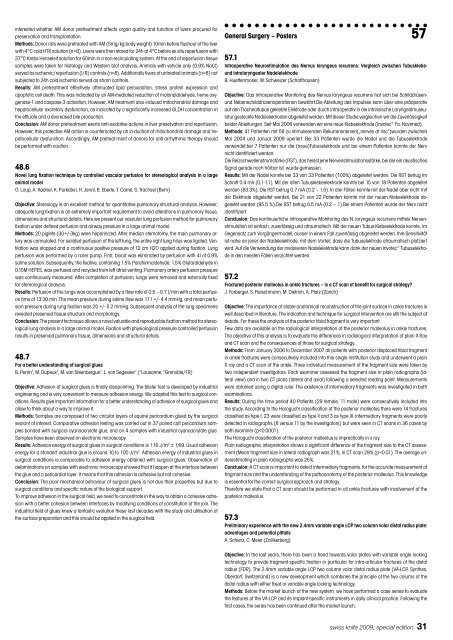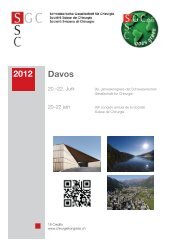Abstracts - Chirurgie Kongress
Abstracts - Chirurgie Kongress
Abstracts - Chirurgie Kongress
Create successful ePaper yourself
Turn your PDF publications into a flip-book with our unique Google optimized e-Paper software.
interested whether AM donor pretreatment affects organ quality and function of livers procured for<br />
preservation and transplantation.<br />
Methods: Donor rats were pretreated with AM (5mg/kg body weight) 10min before flushout of the liver<br />
with 4°C cold HTK solution (n=8). Livers were then stored for 24h at 4°C before ex situ reperfusion with<br />
37°C Krebs Henseleit solution for 60min in a non-recirculating system. At the end of reperfusion tissue<br />
samples were taken for histology and Western blot analysis. Animals with vehicle only (0.9% NaCl)<br />
served as ischemic/reperfusion (I/R) controls (n=8). Additionally livers of untreated animals (n=8) not<br />
subjected to 24h cold ischemia served as sham controls.<br />
Results: AM pretreatment effectively attenuated lipid peroxidation, stress protein expression and<br />
apoptotic cell death. This was indicated by an AM-mediated reduction of malondialdehyde, heme oxygenase-1<br />
and caspase-3 activation. However, AM treatment also induced mitochondrial damage and<br />
hepatocellular excretory dysfunction, as indicated by a significantly increased GLDH concentration in<br />
the effluate and a decreased bile production.<br />
Conclusion: AM donor pretreatment exerts anti-oxidative actions in liver preservation and reperfusion.<br />
However, this protective AM action is counteracted by an in-duction of mitochondrial damage and hepatocellular<br />
dysfunction. Accordingly, AM pretreat-ment of donors for anti-arrhythmic therapy should<br />
be performed with caution.<br />
48.6<br />
Novel lung fixation technique by controlled vascular perfusion for stereological analysis in a large<br />
animal model<br />
O. Loup, A. Kadner, K. Purkabiri, H. Jenni, B. Eberle, T. Carrel, S. Trachsel (Bern)<br />
Objective: Stereology is an excellent method for quantitative pulmonary structural analysis. However,<br />
adequate lung fixation is an extremely important requirement to avoid alterations in pulmonary tissue,<br />
dimensions and structural details. Here we present our vascular lung perfusion method for pulmonary<br />
fixation under defined perfusion and airway pressure in a large animal model.<br />
Methods: 20 piglets (30+/-3kg) were heparinized. After median sternotomy, the main pulmonary artery<br />
was cannulated. For isolated perfusion of the left lung, the entire right lung hilus was ligated. Ventilation<br />
was stopped and a continuous positive pressure of 12 cm H2O applied during fixation. Lung<br />
perfusion was performed by a roller pump. First, blood was eliminated by perfusion with 4l of 0.9%<br />
saline solution. Subsequently, the fixative, containing 1.5% Paraformaldehyde; 1.5% Glutaraldehyde in<br />
0.15M HEPES, was perfused and recycled from left atrial venting. Pulmonary artery perfusion pressure<br />
was continuously measured. After completion of perfusion, lungs were removed and externally fixed<br />
for stereological analysis.<br />
Results: Perfusion of the lungs was accomplished by a flow rate of 0.5 – 0.7 l/min with a total perfusion<br />
time of 13‘30 min. The mean pressure during saline flow was 17.1 +/- 4.4 mmHg, and mean perfusion<br />
pressure during lung fixation was 20 +/- 5.2 mmHg. Subsequent analysis of the lung specimens<br />
revealed preserved tissue structure and morphology.<br />
Conclusion: The present technique allows a novel valuable and reproducible fixation method for stereological<br />
lung analysis in a large animal model. Fixation with physiological pressure controlled perfusion<br />
results in preserved pulmonary tissue, dimensions and structural details.<br />
48.7<br />
For a better understanding of surgical glues<br />
B. Perrin 1 , M. Dupeux 2 , M. van Steenbergue 1 , L. von Segesser 1 ( 1 Lausanne, 2 Grenoble/FR)<br />
Objective: Adhesion of surgical glues is finally disapointing. The blister test is developed by industrial<br />
engineering and is very convenient to measure adhesion energy. We adapted this test to surgical conditions.<br />
Results give important information for a better understanding of adhesion of surgical glues and<br />
allow to think about a way to improve it.<br />
Methods: Samples are composed of two circular layers of equine pericardium glued by the surgical<br />
sealant of interest. Comparative adhesion testing was carried out in 37 paired calf pericardium samples<br />
bonded with surgical cyanoacrylate glue, and on 4 samples with industrial cyanoacrylate glue.<br />
Samples have been observed on electronic microscopy.<br />
Results: Adhesion energy of surgical glues in surgical conditions is 1.16 J/m 2 ± 1,69. Usual adhesion<br />
energy for a standart industrial glue is around 10 to 100 J/m 2 . Adhesion energy of industrial glues in<br />
surgical conditions is comparable to adhesion energy obtained with surgical glues. Observation of<br />
delaminations on samples with electronic microscopy showed that it happen at the interface between<br />
the glue and a pericardial layer. It means that this adhesion is adhesive but not cohesive.<br />
Conclusion: The poor mechanical behaviour of surgical glues is not due their properties but due to<br />
surgical conditions and specific nature of the biological support.<br />
To improve adhesion in the surgical field, we need to concentrate in the way to obtain a cohesive adhesion<br />
with a better cohesion between interfaces by modifying conditions of constitution of the join. The<br />
industrial field of glues knew a fantastic evolution these last decades with the study and utilisation of<br />
the surface preparation and this should be applied in the surgical field.<br />
General Surgery – Posters 57<br />
57.1<br />
Intraoperative Neurostimulation des Nervus laryngeus recurrens: Vergleich zwischen Tubusklebe-<br />
und intralaryngealer Nadelelektrode<br />
B. Huettenmoser, W. Schweizer (Schaffhausen)<br />
Objective: Das intraoperative Monitoring des Nervus laryngeus recurrens hat sich bei Schilddrüsen-<br />
und Nebenschilddrüsenoperationen bewährt.Die Ableitung des Impulses kann über eine präoperativ<br />
auf den Trachealtubus geklebte Elektrode oder durch intraoperativ in die intrinsische Laryngealmuskulatur<br />
gesteckte Nadelelektroden abgeleitet werden. Mit dieser Studie vergleichen wir die Zuverlässigkeit<br />
beider Ableitungen. Seit Mai 2006 verwenden wir eine neue Klebeelektrode (Invotec ® Fa. Novimed).<br />
Methods: 41 Patienten mit 58 zu stimulierenden Rekurrensnerven(„nerves at risc“)wurden zwischen<br />
Mai 2004 und Januar 2009 operiert. Bei 33 Patienten wurde die Nadel und die Tubuselektrode<br />
verwendet,bei 7 Patienten nur die (neue)Tubuselektrode und bei einem Patienten konnte der Nerv<br />
nicht identifiziert werden.<br />
Die Reizschwellenstromstärke (RST), das heisst jene Nervenstimulationsstärke, bei der ein akustisches<br />
Signal gerade noch hörbar ist, wurde gemessen.<br />
Results: Mit der Nadel konnte bei 33 von 33 Patienten (100%) abgeleitet werden. Die RST betrug im<br />
Schnitt 0.4 mA (0.1-1.1). Mit der alten Tubusklebeelektrode konnte bei 15 von 18 Patienten abgeleitet<br />
werden (83.3%). Die RST betrug 0.7 mA (0.2 – 1.5). In drei Fällen konnte mit der Nadel aber nicht mit<br />
der Elektrode abgeleitet werden. Bei 21 von 22 Patienten konnte mit der neuen Klebeelektrode abgeleitet<br />
werden (95.5 %).Die RST betrug 0.5 mA (0.2 – 1).Bei einem Patienten wurde der Nerv nicht<br />
identifiziert.<br />
Conclusion: Das kontinuierliche intraoperative Monitoring des N. laryngeus recurrens mittels Nervenstimulation<br />
ist einfach, zuverlässig und atraumatisch. Mit der neuen Tubus-Klebeelektrode konnte, im<br />
Gegensatz zum Vorgängermodell, ausser in einem Fall zuverlässig abgeleitet werden. Ihre Sensitivität<br />
ist nahe an jener der Nadelelektrode, mit dem Vorteil, dass die Tubuselektrode atraumatisch platziert<br />
wird. Auf die Verwendung der invasiveren Nadelelektrode kann dank der neuen Invotec ® Tubuselektrode<br />
in den meisten Fällen verzichtet werden.<br />
57.2<br />
Fractured posterior malleolus in ankle fractures – is a CT scan of benefit for surgical strategy?<br />
J. Forberger, S. Fleischmann, M. Dietrich, A. Platz (Zürich)<br />
Objective: The importance of stable anatomical reconstruction of the joint surface in ankle fractures is<br />
well described in literature. The indication and technique for surgical intervention are still the subject of<br />
debate. For these the analysis of the posterior tibial fragment is very important.<br />
Few data are available on the radiological interpretation of the posterior malleolus in ankle fractures.<br />
The objective of this analysis is to evaluate the differences in radiological interpretation of plain X-Ray<br />
and CT scan and the consequences of those for surgical strategy.<br />
Methods: From January 2006 to December 2007 all patients with posterior displaced tibial fragment<br />
in ankle fractures were consecutively included into this single institution study and underwent a plain<br />
X ray and a CT scan of the ankle. Three individual measurement of the fragment size were taken by<br />
two independent investigators. Each examiner assessed the fragment size in plain radiographs (lateral<br />
view) and in two CT plans (lateral and axial) following a selected reading point. Measurements<br />
were obtained using a digital ruler. The existence of intermediary fragments was investigated in both<br />
examinations.<br />
Results: During the time period 40 Patients (29 female, 11 male) were consecutively included into<br />
the study. According to the Haraguchi classification of the posterior malleolus there were 14 fractures<br />
classified as type I, 23 were classified as type II and 3 as type III. Intermediary fragments were poorly<br />
detected in radiographs (8 versus 11 by the investigators) but were seen in CT scans in 36 cases by<br />
both examiner (p



